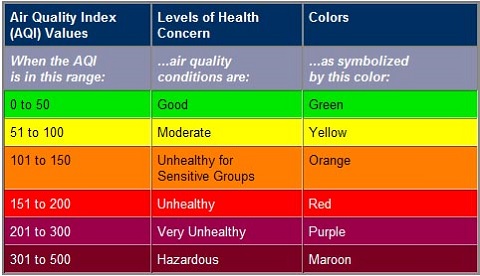About Air Pollution
How do you judge how clean the air outside is? If you're like many people, you check to see how clear the sky is, or what the "visibility" is like.
While visibility can tell you something about the levels of certain types of pollutants in the air, it doesn't provide a complete picture of air quality. Certain types of pollutants like ozone and carbon monoxide have little effect on visibility; very high concentrations of these gases can be present even on the clearest day.
The U.S. Environmental Protection Agency (U.S. EPA) has created a better indicator of air quality, the Air Quality Index, or AQI. The AQI is calculated based on the levels of five major pollutants in the air: ground-level ozone, particle pollution, carbon monoxide, nitrogen dioxide, and sulfur dioxide. Monitors at more than a thousand locations across the country record the concentrations of these pollutants each day. These measurements are used to calculate AQI values for each of the individual pollutants as well as an overall AQI for the day.
The Air Quality Index runs from 0 to 500: the larger the number, the greater the level of air pollution. To make it easier to use, the index is broken down into six general categories, each category corresponding to a different level of health concern. When the air quality index value is between 101 and 150, for example, air quality is considered to be "unhealthy for sensitive groups", like people with heart or lung disease; when the value rises to above 200, air quality is considered "very unhealthy" or "hazardous" for the entire population. To check the AQI in your area, visit AirNow.

*Groups that are unusually sensitive to air pollution include individuals with heart and lung disease, children and older adults.
Simply knowing what the air quality is like, doesn't protect you against the harmful effects of air pollution. That's why the U.S. EPA developed a set of recommendations for each of the individual pollutants. The precautions coincide with the six air quality categories. For example, when the AQI for ozone rises above 150, children and older adults as well as people with lung disease are cautioned to reduce prolonged or heavy exertion outdoors; when the AQI for sulfur dioxide rises above 200, children and people with heart or lung disease are encouraged to avoid outdoor exertion entirely. A complete set of recommendations can be found in the U.S. EPA's publication, Air Quality Index: A Guide to Air Quality and Your Health.
You May Be Interested In...
Air Quality Forecasts and Advisories
- Current Air Quality, Forecasts and Advisories - South Coast Air Quality Management District
- Current Advisories & Alerts - Los Angeles County Department of Public Health
- Archived Advisories and Alerts - Los Angeles County Department of Public Health
Links
- AirNow - National Association of Clean Air Agencies
- American Lung Association
- Health & Air Pollution - California Air Resources Board
- Office of Air and Radiation (OAR) - U.S. Environmental Protection Agency
- South Coast Air Quality Management District




